Are you looking for a new adventure that combines the thrill of fishing with the freedom of the open beach? Look no further than surf fishing. This exciting sport allows you to catch a wide variety of fish while enjoying the beautiful outdoors. It’s perfect for beginners who want to learn the basics of fishing in a fun and relaxed environment.
To get started with surf fishing, you’ll need to understand the surf zone, which is the area where the waves break on the shore. This zone can be challenging to navigate, but with the right gear and techniques, you’ll be able to catch plenty of fish.
In this guide, we’ll show you everything you need to know to get started with surf fishing, including essential gear, choosing the right fishing spot, and techniques for catching fish on the beach. So grab your gear and get ready to experience the freedom of the open sea.
Key Takeaways
– Surf fishing is a fun and relaxed way for beginners to learn about fishing.
– Precautions such as protective clothing and checking local fishing regulations are necessary when surf fishing.
– Timing, location, and equipment are important factors to consider when surf fishing.
– Ethical fishing practices and fish preservation are critical in surf fishing.
Understanding the Surf Zone
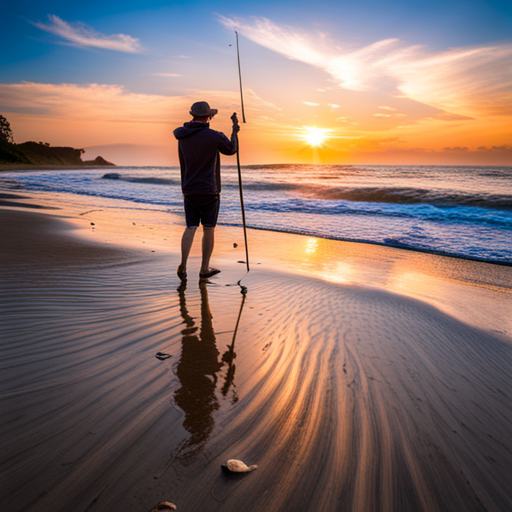
You gotta understand the surf zone if you wanna catch some fish on the beach. The surf zone is the area where the waves break and crash onto the shore. It’s important to be aware of the hazards that come with the surf zone, like rip currents and sandbars.
Rip currents are strong currents that flow away from the shore and can drag you out to sea. Sandbars are underwater ridges that can cause waves to break suddenly and can be dangerous if you’re caught in one.
To avoid these hazards while surf fishing, it’s important to be observant and aware of your surroundings. Take the time to study the waves and the patterns they create. This will help you locate fish in the surf zone. Reading the waves is a skill that takes time to develop, but with practice, you can learn to spot the areas where fish are likely to be found.
Look for areas where the waves are breaking more gently, as this is where fish are likely to be feeding. Remember to always be cautious when fishing in the surf zone. Pay attention to the weather and the conditions of the water. If the waves are too high or the current is too strong, it’s best to wait for calmer conditions.
By understanding the surf zone and being aware of the hazards, you can have a safe and successful surf fishing experience.
Essential Gear for Surf Fishing
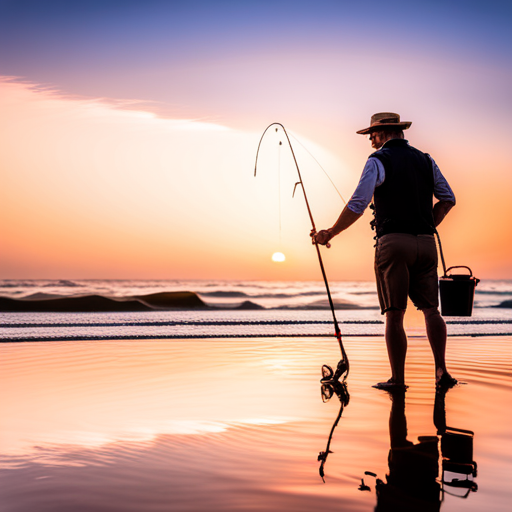
Don’t forget to pack your rod and reel, bait and tackle, because they’re the essential gear for surf fishing.
When it comes to choosing your rod and reel, you need to consider the size of the fish you’re targeting, the type of bait you’ll be using, and the conditions of the surf. A heavy-duty rod and reel are ideal for catching bigger fish, while a lighter set is suitable for smaller ones.
As for bait and tackle, you can choose from a variety of options, such as live bait, lures, and artificial bait.
Aside from your fishing gear, you also need to pack protective clothing and sunscreen. Surf fishing exposes you to the sun and ocean elements, which can be harmful to your skin and health. Wear protective clothing, such as a hat, sunglasses, long-sleeved shirt, and pants. Use sunscreen with a high SPF to protect your skin from the harmful UV rays. Also, wear shoes that are comfortable and slip-resistant, as the surf can be slippery and dangerous.
Bring a cooler full of drinks and snacks to keep you hydrated and energized throughout your fishing trip. Choose snacks that are easy to eat and won’t spoil quickly, such as nuts, fruit, and energy bars. Make sure to bring enough water to keep you hydrated, as the sun and saltwater can cause dehydration.
With the right gear and provisions, you can enjoy your surf fishing trip and catch fish like a pro.
Choosing the Right Fishing Spot
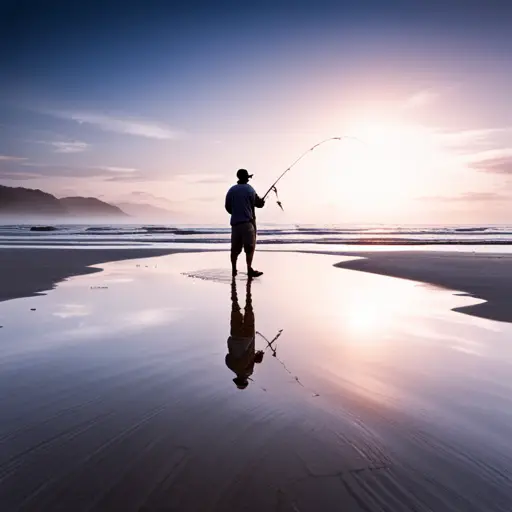
To find the perfect spot for your angling adventure, it’s important to scout the coastline for areas with strong currents and underwater structures. Look for areas where the waves break, creating a natural feeding ground for fish. Rocky outcroppings, jetties, and sandbars also attract fish and can provide shelter from the current.
Once you’ve identified potential spots, check local fishing regulations to ensure you’re not breaking any laws. Some areas may have restrictions on certain fish species, fishing methods, or catch limits.
Additionally, consider talking to local bait shops or fishermen to get insider knowledge on where the fish are biting and what bait is working best. Remember that the best fishing spots may require a bit of a trek to get to, so be prepared to hike down the beach with all your gear.
But trust us, the effort will be worth it once you’re reeling in your first catch. With a little bit of research and patience, you’ll soon be a pro at picking out the prime fishing spots along the coast.
Best Times to Fish

When it comes to fishing, timing is crucial. The best times to fish are influenced by various factors, such as tides and currents, weather conditions, and time of day. Knowing how these elements work together can make a significant difference in your success as a surf angler.
Let’s dive into each of these factors and explore how they impact your chances of catching fish on the beach.
Tides and Currents
Believe it or not, the tides and currents are actually your friends when it comes to surf fishing. Understanding them can lead to a more successful day of fishing.
Rip currents, which are strong, narrow currents that flow away from the shore, can actually be good for fishing. They create channels that baitfish use to navigate through the surf, which in turn attracts larger fish looking for an easy meal.
It’s important to also pay attention to tidal charts. Tides can affect the depth of the water and the location of fish. High tides can push fish closer to shore, while low tides can expose sandbars and other structures that can be prime fishing spots.
Knowing the tides and currents can help you choose the best time and location to cast your line, increasing your chances of a successful catch. So, embrace the tides and currents, and let them guide you to your next big catch.
Weather Conditions
The sky’s hues of pink and orange as the sun sets often signal calm and ideal weather conditions for a successful day of surfcasting. However, weather conditions can change quickly, and it’s important to be prepared for any situation. Here are a few things to keep in mind when it comes to weather and surf fishing:
– Preparing for rain: Always bring rain gear with you when surf fishing, even if it doesn’t look like rain. A sudden downpour can ruin your day if you’re not prepared. It’s also a good idea to bring a waterproof bag to keep your gear dry.
– Windy conditions and surf fishing: Wind can make casting difficult, so it’s important to adjust your technique accordingly. If the wind is coming from the side, try casting at a slight angle to compensate. If it’s coming from behind, be careful not to overcast your target.
– Dealing with hot and sunny weather while surf fishing: Sunscreen is a must when surf fishing on a hot, sunny day. Make sure to apply it liberally and often to avoid getting burned. It’s also a good idea to bring a hat and sunglasses to protect your face and eyes from the sun. Lastly, make sure to stay hydrated by bringing plenty of water with you.
By keeping these tips in mind, you’ll be able to handle whatever weather conditions come your way and enjoy a successful day of surf fishing.
Time of Day
Now that you have a good understanding of how weather conditions can affect your surf fishing experience, let’s talk about the time of day. The time of day is another crucial factor that can make or break your chances of catching fish on the beach.
Early morning and late afternoon are the best times to go surf fishing. During these times, the water temperature is cooler, and the fish tend to be more active and feeding closer to the shore. When the sun is high in the sky, the water temperature can rise, causing the fish to move further out into deeper waters, making it harder to catch them from the shore. To help you plan your surf fishing trip, take a look at the table below, which outlines the best times to go surf fishing during different seasons.
| Season | Best Time to Go Surf Fishing |
|---|---|
| ——– | —————————— |
| Spring | Early Morning or Late Afternoon |
| Summer | Early Morning or Late Afternoon |
| Fall | Early Morning or Late Afternoon |
| Winter | Late Afternoon or Early Evening |
Remember, the time of day can vary depending on the season and location, so be sure to do your research before heading out. By going surf fishing during the early morning or late afternoon, you can increase your chances of catching fish and have a more successful and enjoyable experience on the beach.
Techniques for Surf Fishing
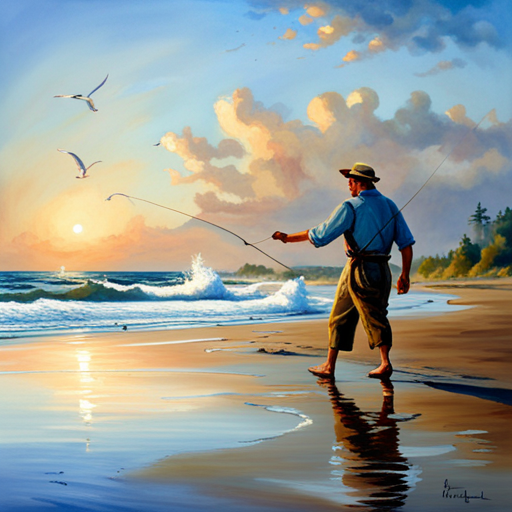
To improve your chances of catching fish while surf fishing, you should try casting your bait in different spots along the beach. Here are some techniques to help you get started:
– Cast into the waves: Fish often gather where the waves break, so try casting your line just beyond the surf. This is where you’re most likely to find predatory fish looking for food.
– Use a fish finder rig: This is a popular rig for surf fishing because it helps you locate fish that are feeding near the bottom. The rig consists of a sinker, a leader, and a hook with bait. The sinker sits on the bottom, while the bait moves around with the waves.
– Vary your retrieve: If you’re not getting any bites, try changing your retrieve speed. Sometimes fish are more attracted to a fast-moving bait, while other times they prefer a slow and steady retrieve.
Remember, surf fishing is all about experimentation. Don’t be afraid to try different techniques until you find what works best for you. With a little patience and persistence, you’ll soon be reeling in a catch that’ll make your day.
Catching and Handling Fish
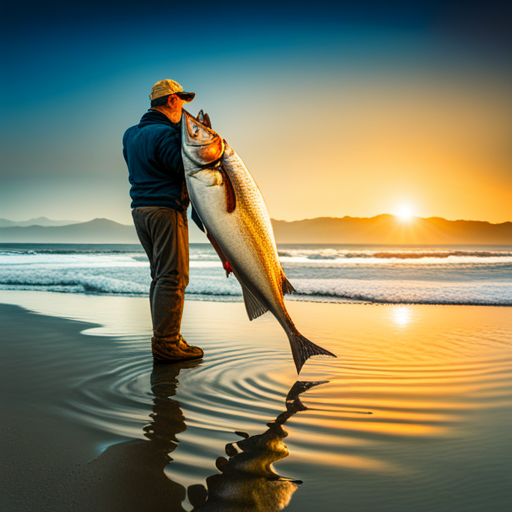
When you reel in a catch, it’s important to handle the fish with care to ensure its survival. Fish preservation is critical, and ethical fishing practices are essential to protect the environment.
First, you need to keep the fish in the water as much as possible. Avoid handling it with your bare hands, as this removes the protective slime that covers its skin. Use a wet towel or gloves to handle the fish gently.
Secondly, you should remove the hook as quickly as possible. If the hook is deeply embedded, use a pair of pliers to remove it. If you can’t remove the hook, cut the line as close to the hook as possible. Don’t try to pull the hook out, as this can injure the fish.
Finally, return the fish to the water as soon as possible. Hold it gently by the tail and move it back and forth to help it regain its strength. Once it starts to swim, let go of its tail and watch it swim away.
Catching and handling fish requires proper techniques to ensure the fish’s survival. Fish preservation is essential, and ethical fishing practices protect the environment.
Tips for Success

If you want to increase your chances of success while angling, it’s important to pay attention to the weather and water conditions. For example, if the water is too murky, try using bright or flashy lures to attract fish.
Another tip is to choose bait that is appropriate for the fish species you’re targeting. Learn about the feeding habits of the fish you want to catch and choose bait that mimics their natural prey.
Finding fish schools is also important when surf fishing. Look for areas where the waves break and the water is shallow. This is where fish are more likely to be feeding. Use polarized sunglasses to help spot fish in the water. Additionally, pay attention to birds flying over the water as they can indicate where schools of fish are located.
Don’t be afraid to experiment with different techniques and lures. Sometimes what worked yesterday might not work today. Bring a variety of lures and try different retrieval speeds and depths until you find what works. And remember, patience is key. Don’t give up too quickly and keep trying until you find success.
By following these tips, you’ll increase your chances of catching fish while surf fishing.
Frequently Asked Questions
What types of fish can be caught while surf fishing?
You can catch a variety of fish while surf fishing, depending on the location and equipment used. Popular locations include rocky shores, jetties, and estuaries. The best equipment includes rods, reels, and lures appropriate for the species targeted.
Is a fishing license required for surf fishing?
Yes, a fishing license or permit is required for surf fishing in most places. Beach regulations vary by location, so it’s best to check with local authorities before heading out to catch some fish.
How can I predict the tides and currents for better fishing success?
To predict tides and currents for better fishing success, you need to understand the science of tides forecasting and how weather patterns affect wind direction. Knowing this will help you catch more fish and give you the freedom to explore new fishing spots.
What safety precautions should I take while surf fishing?
Beach hazards are no joke. Wear proper attire, like sturdy shoes and a hat, to protect yourself from the sun and sharp objects. Stay alert, and always be aware of your surroundings. Safety first, freedom second.
Can I use live bait or lures for surf fishing?
When surf fishing, you can use live bait or lures. The live bait vs. lures debate is ongoing, but some of the best live bait options for surf fishing include sand crabs, clams, and bloodworms. Experiment to see what works best for you.
Conclusion
Congratulations! You now have a solid understanding of how to surf fish. Remember to always be aware of the surf zone, and to choose the right gear and spot for optimal results. Don’t forget to fish during the best times, and to use proper techniques to attract and catch fish.
But your journey doesn’t end there. Keep in mind that catching and handling fish properly is crucial for a successful day of fishing. Always handle fish with care and respect, and release any that you don’t intend to keep.
In the end, surf fishing is a rewarding and exciting way to spend a day at the beach. With the right knowledge and gear, you can become an experienced angler and enjoy the thrill of reeling in a big catch.
So grab your gear, head to the beach, and start your journey towards becoming a successful surf fisherman.

